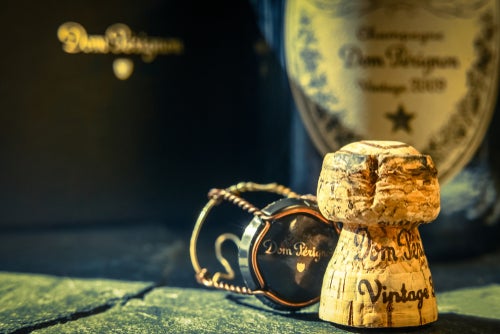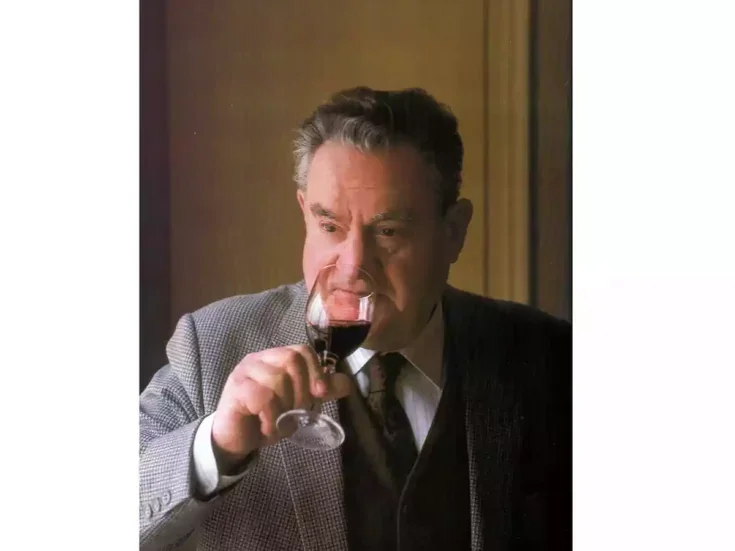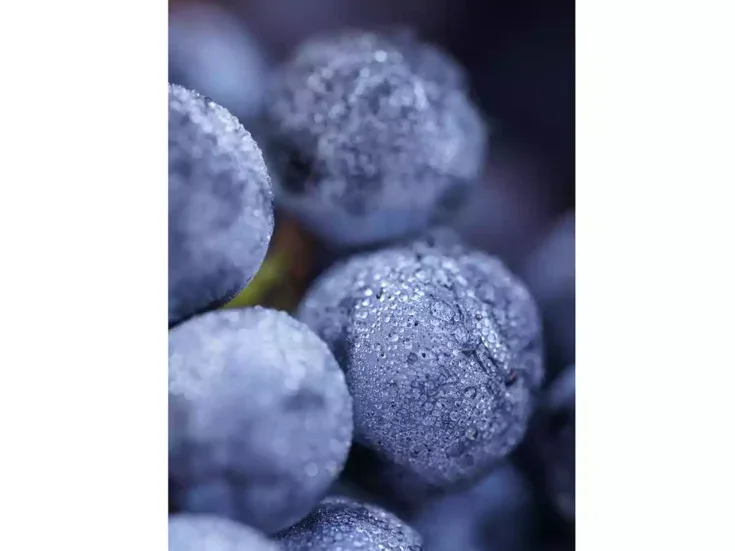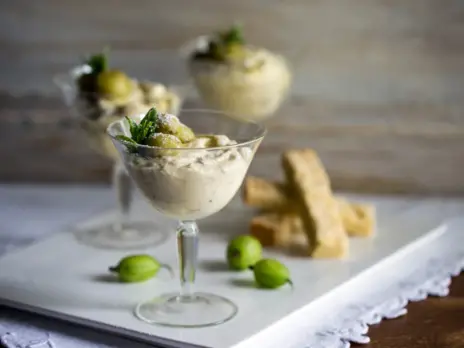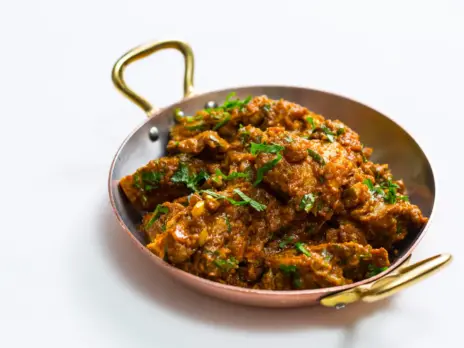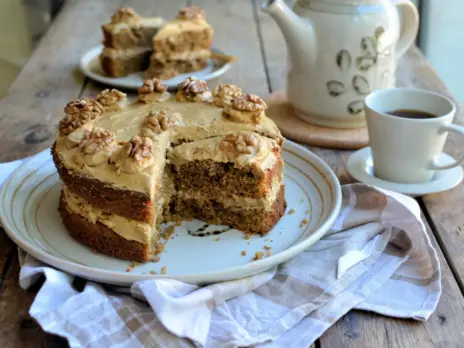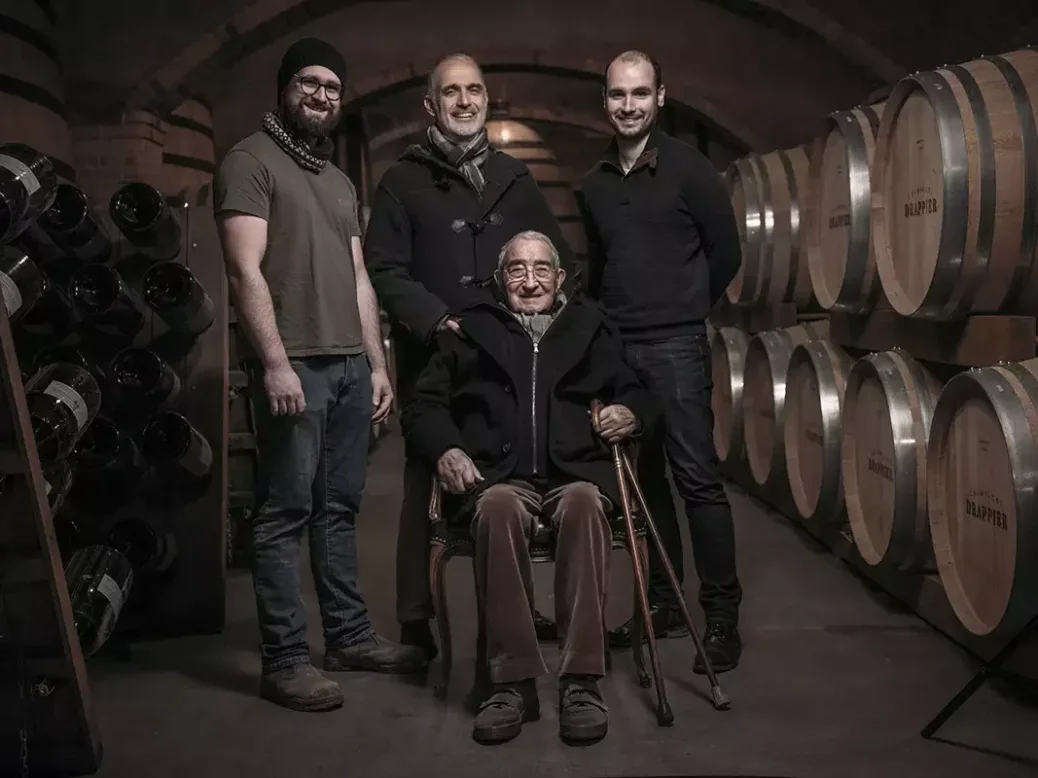
André Drappier, the creator of Champagne Drappier in the Côte des Bar, died on March 5, 2025 in his 99th year. I visited shortly afterwards to interview André’s and his wife Micheline’s only son Michel, who has long led the house since his father retired and is now himself handing over to daughter Charline and sons Hugo and Antoine. Some 500 people, local and from all over Champagne, attended the Église Saint-Pierre-ès-Liens in Urville for the funeral, many of them in the open air as the church overflowed. Michel Drappier and Jean-Luc Barbier, former Director of the Comité Interprofessionnel du Vin de Champagne, addressed the congregation.
Champagne Drappier sits comfortably among the elite of the Champagne firmament, yet this gently cloaks a remarkable singularity. It is the only major négociant house developed directly from a family of grape growers. André Drappier built the house’s foundations, and his place as one of Champagne’s revered sons and unassuming heroes might have rested there. But the wider significance of his work is that the creation of the Drappier Champagne brand not only put the Aube on Champagne’s map, but helped remove much of its Cinderella stigma as “deuxième zone” in respect to the Marne’s supposed superiority. Even after the Aube’s legal reintegration into the Champagne appellation of 1927, the practical obligation of unity with the Marne required that Gamay—by far and away the most-planted grape variety in the Aube during the inter-war years—be replaced with Pinot Noir. The Drappier family, among others, wholly endorsed that. André’s father-in-law Georges, who died in 1967 aged 71, was called “Père Pinot” for his pains, and André enthusiastically took over the baton. In 1951, only one seventh of the Aube vineyard was planted to Pinot Noir. Today, it’s more than six sevenths, and the Aube produces more than half of all the Pinot Noir in Champagne.
Hard work and quiet magic
André was born in 1926, a very good, warm harvest, to the sixth generation of a “grower” domaine established in 1808. Yet Champagne’s 1926 phylloxera-shrunk vineyard of 12,000ha (29,650 acres)—it is 34,000ha (84,000 acres) today—fought in a market ravaged by World War I, then the Great Depression and World War II. Champagne historian Nicholas Faith dubbed 1914–54 “forty terrible years.” In 1947, aged 21, after studying, André worked his first serious vintage on the tiny 6ha (15-acre) Urville estate, and the family still tell the story of him being allotted the biggest hod in which to carry grapes up the steepest slopes, to break him in to a family tradition of hard work and commitment. Some 20 years later, by the time of his father’s death, André had worked a quiet magic, whose practical result was the acquisition of vineyard land and the planting of Pinot Noir. Shrewd, instinctive, or simply inspired, it all paid off.
André himself, interviewed in the Aube in 2011, said: “From three, four, five hectares, we jumped, between 1960 and 1970, to ten hectares, and fifteen hectares, and so on. The hectares just kept coming… It happened very quickly.” One might hear there the voice of a tyro entrepreneur, but Michel Drappier credits more the necessity of hardship. Imagine a family in which shoes were handed down to children when elders outgrew them. And where unremitting vineyard work set the agenda. Michel describes his father as instinctively hard-working, and as the small business grew, he was the first to arrive for work, then the last to leave and lock up. “No hunting. No going to the theater. He just worked,” Michel remarks. Yet I might add that whenever I met him, on several occasions, he was far from dour; his eyes wore a penetrating twinkle, his speech carried a mordant wit, and every encounter left me happier.
Leadership by example, the importance of family solidarity, and the absence of any arrogance were there aplenty, and Michel admits that this selfless example of how to drive a family enterprise became ingrained from his father. As he put it to me: “For me, it’s like breathing, and I owe him that.” While mourning the loss of his father, Michel also repeatedly recognizes his mother Micheline’s huge contribution to the family’s success.
Michel is quick to add that his father’s groundwork, and his own work to take the Drappier brand to new markets, benefited from the “trente glorieuses [années]” from 1945 to 1975, when modern Champagne came of age with branding and export-led expansion. But sheer hard work and economic booms required another factor in the trifecta of Drappier’s business success: André Drappier’s shrewd identification of opportunity and the guts to risk and commit to opportunities as they emerged. He allowed Michel to become one of Champagne’s most innovative modern winemakers, leading winemaking at Drappier since 1979, steering the house into “négociant” status as late as 1986, and the more international ambassadorial role that demanded.
A lasting legacy
Unquestionably, the inaugural masterstroke of André’s career was the launch of the branded cuvée Carte d’Or in 1951. Wary of any potential conflict with Veuve Clicquot Ponsardin’s “carte jaune” label, in use since 1862, Drappier avoided the problem with a paler label that they compared to the color of quince jelly, rather than Clicquot’s legendary references to the color of the yolk of Bresse chickens! Drappier had sold grapes to their distant Reims neighbor for 70 years! In 1957, a dash of Meunier was adroitly added to the blend as a hedge against the predations of frost. And it certainly helped that the local Bayel-based fine wineglass maker, Cristalleries Royales de Champagne, became a customer, since Drappier had supplied them with furnace wood many years before. Later, UK merchant Anthony Byrne was to visit the factory and eventually became Drappier’s first UK importer. Nowadays the house is a “boutique” making some one million bottles per annum.
André Drappier’s legacy—beyond the house itself, beyond the beacon that has boosted the Aube’s contribution to Champagne—is the local roots and the village vineyards of Urville as the raison d’être of its wines. Local sales to former President de Gaulle’s Colombey-les-Deux-Églises home were a discreet fact long before the Parisian press reported on the General’s “favorite” wine. André’s 1950 purchase of the former Abbey of Clairvaux’s wine cellars in Urville from the municipality created an inspired emblem of tradition: wine’s past in the present. The emphasis on the local terroir, carbon neutrality, and sustainability as the stylistic key to understanding their wines is today underlined with more than 70ha (173 acres) of vineyards certified organic, and with the prestige cuvée, Grande Sendrée, originating in a single vineyard (first released from the 1975 vintage). The range also highlights minority grape varieties Petit Meslier, Blanc Vrai, Pinot Gris, and Arbanne.
Some argue that the key to a brand’s success is less its physical form, but the desire and contentment engendered in our hearts. Remarkably, if you visit Urville you might miss the Drappier winery and headquarters altogether, as no signage will alert you to them. Unsuspecting, you could drive along the bucolic and woodsmoke-scented main street, Rue des Vignes, not knowing Champagne Drappier was there, until you took a side street and suddenly saw the ticking complex before you. André Drappier would be amused by this, and went to his rest satisfied that he made much-loved Champagnes that disturb neither the roots of his village nor the wider Côte des Bar whence they come.

